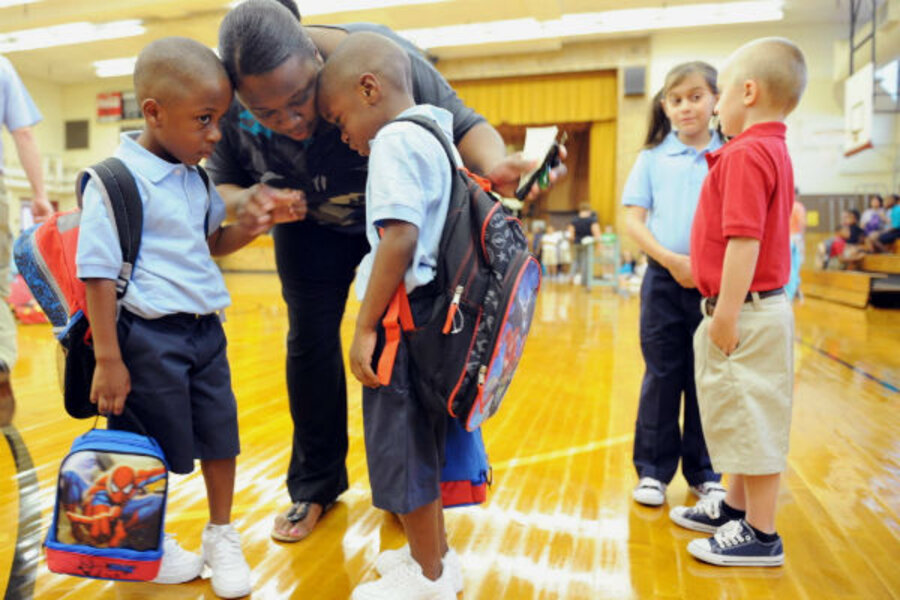Kindergarten mindset list: 5-year-olds’ cultural DNA
Loading...
| Philadelphia
Each fall, Beloit College (Wisc.) publishes its “Mindset List:” 75 points of reference for understanding the cultural profile of their incoming freshmen class. More than just a core sampling of the historical events that an 18-year-old would, or would not, have experienced, the list holds a mirror up to the formative experiences for those new students – and, therefore, for their professors.
For instance, the Beloit Mindset List for the post-millennial class of 2014 included the following items:
1. Few in the class know how to write in cursive.
2. E-mail is just too slow, and they seldom if ever use snail mail.
3. Entering college this fall in a country where a quarter of young people under 18 have at least one immigrant parent, they aren’t afraid of immigration … unless it involves “real” aliens from another planet.
4. They never twisted the coiled handset wire aimlessly around their wrists while chatting on the phone.
5. The first home computer they probably touched was an Apple II or Mac II; they are not in the museum.
6. American companies have always done business in Vietnam.
7. Nirvana is on the classic oldies station.
8. Ruth Bader Ginsburg has always been on the US Supreme Court.
One might add, many in this class will have attended the most successful movie opening – indeed, franchise – of all time, a movie series that defines their childhood reading habits: Harry Potter.
You get the idea. Based on the list, you can “grok” 360 degrees of the experiences that have contributed to the mindset of people of a certain age. I shudder to think of the mindset list for my own freshman class, the college class of 1978. As I’m fond of telling my children, the laptop I went to school with was an Olivetti portable typewriter. A computer was a big teletype machine that only the math club (all boys) knew how to use. Telephones had dials. Tape cassettes were the newest audio advancement.
This mindset, however, refers to a world writ large, a context inhabited by adults and proto-adults whose cognition can cope simultaneously with abstraction and evolutionary blips and detours. Since I work in an elementary school, our incoming “freshmen” class is five years old. Street-level mindsets for them are quite different – but just as important to understand with accuracy.
One year, when I was principal in a small rural public school in Maine, I wondered, "What is the kindergarten mindset list for my kids? Would their list reveal intriguing things about the rate of change in our local cultural mindsets? What are the innovations or changes that have taken place in a quick five years to which we are already acclimated, but which account for their whole life span? This could yield a core sample of the life of the mind for small town 5-year-olds!"
As it turned out, their mindset list ranged from the sublime to the humorously idiosyncratic. Though a few details … well, most of the details … are decidedly local, you can get a sense of the worldview of any kid beginning the long march toward that freshmen year of post-secondary education. (And how many college freshmen could identify how “The Long March” resonates in our collective historical mindset?)
Here’s what I knew that my students knew:
1. Adams School has always had a green playground structure and timber frame nature center … and a big granite rock by the bike rack. (All of this was just installed in August).
3. School always begins with a parachute game and the principal playing bagpipes on the town common. (We take it one year at a time.)
4. There has never been a merry-go-round or teeter-totter on the playground. (The old playground equipment was removed, alas.)
5. A school computer is called an iBook. (And they probably all know how to do a Google search or Skype Daddy.)
6. The flag always flies at half-mast on Sept. 11.
These are, of course, external factors of a mindset – more the adult mindset for kindergartners. To venture inside their own personal mindset, I invited the freshmen class to my office for a little an interview. Here is an introductory look, in no particular order, for the cultural record. This is where the rubber really meets the road.
1. Charlie drives the bus. I like going home.
2. We have the greatest, greatest time at school.
3. I can do an upside down thing on the playground.
4. I go down the slide backwards with my head pointing forward.
5. We like our teacher.
6. We get to be learned.
7. I’m making a woolly mammoth out of Legos. It evolved into hairless elephants from the Dinophyllus that weighed 14 times as much as a giraffe
8. The first movie I saw in a theater was Cars.
9. My mommy’s name is “Mommy,” and my dad’s name is “Daddy.”
10. Our parents make the best, best ice cream cones and sundaes.
This is where the mindset rubber meets the road. I’m not sure that Beloit College gathers all of the available mindset information, since they list only the chronological experiences available to their freshmen class. I’d like to hear a little more about sliding attitude, teacher appreciation, movie viewing, and ice cream preferences.
Further interviews may be required to complete my findings and connect the dots. Clearly, this is a complex matrix. Beloit has it easy. On the other hand, I have 12 years to prepare the kindergartners I know for Beloit. I’m wondering where to start.
Todd R. Nelson is head of school at The School in Rose Valley.








